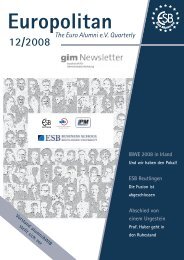Entwicklungen nach Fukushima - ESB-Radler
Entwicklungen nach Fukushima - ESB-Radler
Entwicklungen nach Fukushima - ESB-Radler
Sie wollen auch ein ePaper? Erhöhen Sie die Reichweite Ihrer Titel.
YUMPU macht aus Druck-PDFs automatisch weboptimierte ePaper, die Google liebt.
Matthias Jung (MBA 2009)<br />
energy efficiency is the only real solution. Everything<br />
from mega projects, such as offshore wind farms, hydropower,<br />
solar concentrators, to community-sized offgrid<br />
mini-hydro generators, village biogas digesters,<br />
biofuels, photovoltaic panels and even wave power,<br />
will play a crucial role in Asia’s energy future. In this<br />
respect, looking beyond China and India, the two largest<br />
energy-consuming countries in developing Asia,<br />
can be rather interesting, especially from a business<br />
perspective. Only few countries in the world offer the<br />
renewable energy potential of Indonesia. The country<br />
offers not only opportunities in wind, solar, biomass<br />
and hydropower, it is also home to estimated 40 % of<br />
the world’s known geothermal resources.<br />
Geothermal energy is basically heat from the earth –<br />
clean and sustainable. When magma comes close to the<br />
surface, it heats ground water trapped in porous rock<br />
or water running along fractured rock surfaces and<br />
faults. Those large areas of hydrothermal resources are<br />
called geothermal reservoirs which are deep underground<br />
with no visible signs showing above ground.<br />
Sometimes geothermal energy finds its natural way to<br />
the surface in the form of volcanoes, hot springs or<br />
geysers. The most active geothermal resources are usually<br />
found along major plate boundaries where volcanoes<br />
and earthquakes are concentrated.<br />
Most of the earth’s geothermal activity occurs along<br />
the so-called Ring of Fire which goes around the edges<br />
of the Pacific Ocean. Not surprisingly, the U.S. currently<br />
leads the world with an installed power generating<br />
capacity of geothermal power plants of 3,100 MW, followed<br />
by the Philippines with an installed capacity of<br />
approximately 1,900 MW. Indonesia has currently more<br />
Southeast Asia has always been in the focus of Matthias who started his undergraduate<br />
studies right at the outset of the Asian Financial Crisis in 1997/98.<br />
In his first role as Marketing Manager for Germany’s investment promotion agency<br />
he developed & implemented marketing strategies to attract FDI from Southeast<br />
Asia. After the completion of his MBA program at the <strong>ESB</strong> Reutlingen and Nanyang<br />
Business School in Singapore, he joined Siemens as a Market Analyst for its<br />
oil & gas business in Asia-Pacific.<br />
Matthias is now based in Jakarta and heading the strategic marketing for Siemens<br />
Energy in Southeast Asia.<br />
than 1,300 MW of geothermal capacity, making it the<br />
fourth largest producer of geothermal power in the<br />
world.<br />
Under the second phase of its 10,000 MW power development<br />
plan, the Indonesian government aims to attract<br />
about US$12bn of new investment in the geothermal<br />
sector to boost energy production to 4,000 MW in<br />
the medium term. By 2020, this would bring Indonesia<br />
to the top rank of countries generating power from<br />
geothermal resources. There are a number of advantages<br />
with geothermal energy. Unlike other renewable<br />
resources, particularly wind, that are relatively intermittent,<br />
geothermal energy can provide continuous,<br />
reliable capacity at any given time. In addition, a geothermal<br />
power plant requires a comparatively small<br />
land area per MWh. Hydropower, which offers huge<br />
potential as well, has proven to be a rather unreliable<br />
source of electricity due to the severe droughts plaguing<br />
the region. The economics are also in favor of<br />
geothermal energy. Depending on the scenario for a<br />
plant, the production costs are somewhere between 4 to<br />
10 Euro cents per kWh. This makes geothermal energy<br />
one of the most inexpensive renewable sources of base<br />
load power.<br />
The technology and the maximum size of a geothermal<br />
power plant depend primarily on the temperature of the<br />
site and quality of thermal water. There are two basic<br />
types of plants used to generate electricity, indirect and<br />
direct cycles. In indirect cycles heat of the geothermal<br />
water with temperature of 80°C and above is transferred<br />
via a heat exchanger to a second liquid in an adjacent<br />
loop. This fluid then boils to vapor which powers<br />
the turbine generator. In direct cycle steam with tempe-<br />
Schwerpunkt Erneuerbare Energien – <strong>Entwicklungen</strong> <strong>nach</strong> <strong>Fukushima</strong> 23






